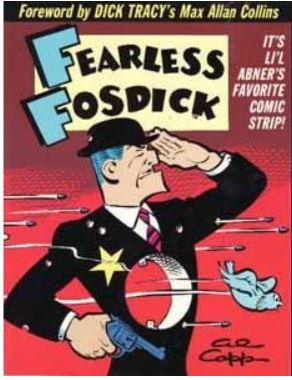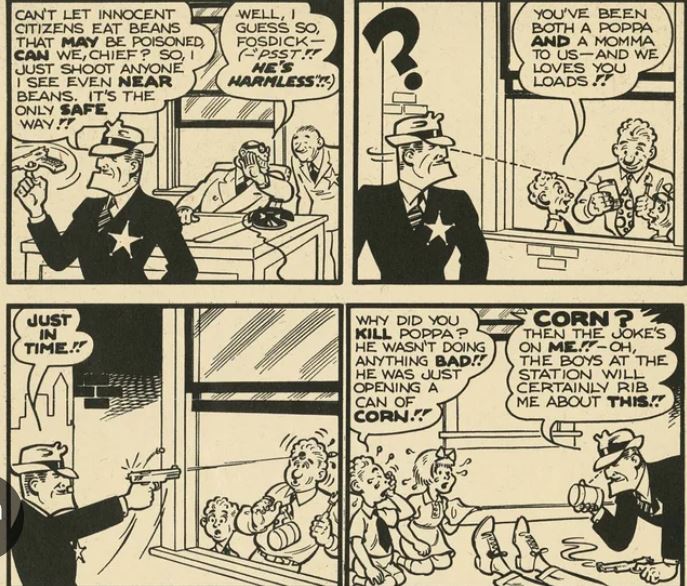
By Al Capp (Kitchen Sink Press)
ISBN: 978-0-87816-108-9 (TPB)
This book includes Discriminatory Content produced in less enlightened times. This book also contains Discriminatory Content included for satirical and comedic effect.
Al Capp’s Li’l Abner is rightly considered one of the greatest comic strips ever created, a devastatingly satirical, superbly illustrated, downright brilliant comedic masterwork which lampooned anything and everything America held dear and literally reshaped their popular culture. Generations of readers took Capp’s outrageous inventions and graphic invectives to their hearts. Many of the strips best lines and terms entered the language, as did the role-reversing college bacchanal known as Sadie Hawkins Day. Some fictional shticks even became licensed and therefore “real” – just Google “Shmoo” and “Kickapoo Joy-juice” to see what I mean.
Apart from the satirical and funny bits you can say pretty much the same about Chester Gould’s legendary lawman Dick Tracy – a landmark creation which has influenced all popular fiction, not simply comics. Baroque villains, outrageous crimes and fiendish death-traps have pollinated the work of numerous strips, shows and movies since then, but the indomitable Tracy’s studied use – and startlingly accurate predictions – of crime fighting technology and techniques gave the world a taste of cop thrillers, police procedurals and forensic mysteries such as CSI decades before our current fascination took hold.

In August 1942 Alfred Gerald Caplin, as he didn’t prefer to be known, took a studied potshot at the cartooning game, joyously biting the hand that fed him (grudgingly and far from enough) when he introduced a frantic, barbed parody of Tracy into Li’l Abner.
As depicted by cartoonist-within-a-cartoon “Lester Gooch”, Fearless Fosdick was a deadpan, compulsively honest, straight-laced cop who worked for a pittance in a corrupt, venal crime-plagued city, controlled by shifty, ungrateful authorities – i.e. typical bosses. Fosdick slavishly followed the exact letter of the law, if not the spirit: always over-reacting, and often shooting litterbugs or Jaywalkers whilst letting bandits and murderers escape.
The extended gag began as a sly poke at strip cartoonists and syndicates whom Capp portrayed as slavering maniacs and befuddled psychotics manipulated by ruthless, shameless, rapacious exploiters. It became so popular on its own admittedly bizarre merits that Fosdick’s sporadic appearances quickly generated licensed toys and games, a TV puppet show and a phenomenally popular advertising deal for Wildroot Cream-Oil hair tonic.

The hard-hitting, obtuse he-man hero was impulsive Abner’s “Ideel” and whenever the crime-crusher appeared as a strip within the strip, the big goof aped his behaviour to outlandish degree. When Fosdick married as part of a bizarre plot, Abner finally capitulated to devoted girlfriend Daisy Mae’s matrimonial aspirations and “married up” too… even though he didn’t really want to!
Fosdick made the jump to comic books when edited reprints of the strip appeared from Toby Press, and a promotional comic – ‘Fearless Fosdick and the Case of the Red Feather’ – followed. Thus in 1956 Simon and Shuster published Al Capp’s Fearless Fosdick: His Life and Deaths which forms the basis of the classy Kitchen Sink softcover under review here.
Prefaced with an absorbing and informative introduction by award-winning crime and comics writer Max Allan Collins – who took over Dick Tracy when Gould retired – this outrageous tome relates five of the very best felonious fiascos and forensic farces beginning with ‘Introducing: AnyFace!’ from 1947, wherein Abner is hired to protect cartoonist Lester Gooch as he crafts the tale of a crook with a plastic face. The fiend is un-catchable since he can mimic anybody, constantly fooling Fosdick into shooting the wrong guy. Eventually the cop starts killing people pre-emptively – just in case – but in the “real” world as Abner gets more engrossed in the serial, Gooch, always as bonkers as a bag of badgers (because only certified loons create comics strips), is suddenly cured, casting the conclusion into desperate doubt! Confused? Good: that’s the point!
From 1950 comes ‘The Case of the Poisoned Beans’ in which madman Elmer Schlmpf randomly contaminates a tin of “Old Faithful” – the city’s most popular brand of beans. So popular are they that most shops and restaurants refuse to take them off sale and the populace won’t stop buying them. As no panic ensues and indifference rages, Fosdick begins shooting citizens who won’t stop eating the beans. Better a safe, clean police bullet than a nasty case of poison…
‘Sidney the Crooked Parrot’ (1953) was once Fosdick’s faithful pet, but living with the obsessive do-gooder turned the bird into a vengeance-crazed criminal genius. Cunningly causing Fearless to lose his job, the bird then organises a campaign of terror, but even humiliated, derelict and starving, the unswerving righteousness of the super-cop finds a way to triumph…
‘The Case of the Atom Bum’ (1951) finds the dapper detective helpless to halt depredations of a radioactive hobo who robs with impunity since the slightest wound might cause him to detonate like a thermonuclear bomb. Forced to ignore and even – shudder!! – abet the ne’er-do-well, Fosdick is going even more insane with frustrated justice – and then he snaps!
This manic monochrome monument to the Bad Old Days concludes with 1948’s utterly surreal ‘Case of the Chippendale Chair’, which begins only after certifiably cured and sane Lester Gooch is kidnapped by thugs working for the syndicate who torture him until he is crazy enough to produce Fearless Fosdick cartoons once more…
Once more demented, Gooch sets to delivering a startling saga of murder, theft and general scofflawing to sate the nation’s desire for graphic gang-busting with a new mastermind ravaging the palaces of the rich. Who can possibly be behind such brilliant crimes? (The clue is in the title…) and as Fosdick ineptly yet unerringly closes in on the culprit, collateral casualties mount. Still, isn’t justice worth a few sacrifices?

Madcap, cynical and hilariously ultra-violent, these eccentric yarns are credited with inspiring Harvey Kurtzman to create Mad comic books and the magazine it became. Capp’s creations clearly shaped decades of American comics comedy. Fosdick kept on turning up until 1972, leavening all the hillbilly high-jinks, satire and social commentary and defanging Capp’s increasingly reactionary stance and declining popularity with healthy, recreational slapstick slaughter, justifiable homicides and anticipatory cold-case clean-up. Moreover, if you’re British, you will see quite a few antecedents of our own utterly rational and reasonable supercop Judge Dredd…
If you have a taste for over-the-top hilarity and stunning draughtsmanship this is a book you must track down. Consider it a constabulary duty to be done…
Strip material © 1947, 1949, 1950, 1951, 1990 Capp Enterprises, Inc. Introduction © 1990 Max Allan Collins. Entire Contents © 1990 Kitchen Sink Press, Inc.
Today in 1907, the first Mutt and Jeff strips by Bud Fisher were published. We already told you that in Forever Nuts: The Early Years of Mutt & Jeff (Classic Screwball Strips). In 1915 Green Lantern originator Martin Nodell was born, whilst comics presence, writer, editor and The Beat blogger Heidi MacDonald joined us in 1961, as did comics colour artist Lee Loughridge (Batman Adventures, Stumptown) in 1969.
